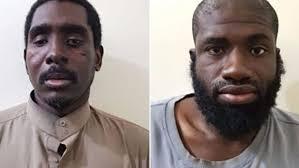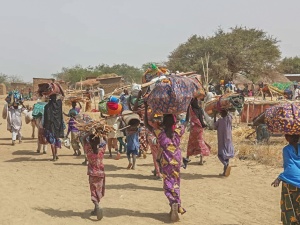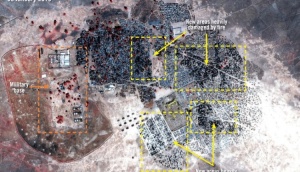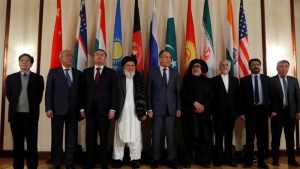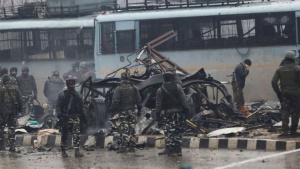
The attack against Indian forces which occurred on February 14 was the deadliest thus far in the Kashmiri insurgency. Image credit: Getty Images.
Jammu and Kashmir (J&K) is one of the most militarized areas in the world. India and Pakistan, both nuclear-armed, have fought three wars since their independence, two of which have been over J&K. The tensions began in 1947 after the two countries won independence from Britain. The second India-Pakistan war in 1965 followed, with the rise of the Jammu Kashmiri Liberation Front – a Kashmiri nationalist organization aiming to unite both the Pakistani- and Indian-administered regions of the territory. More recently, tensions between the two neighbours have flared due to a suicide bombing by an Islamist militant group known as Jaish-e-Muhammad (JeM), or Army of Muhammad, which killed forty Indian paramilitary operatives in the Indian-administered part of J&K. The same group also launched an attack on an Indian army base in Kashmir in 2016, prompting India’s military to cross the border and launch surgical air strikes into Pakistan.
For Pakistan, Islamist groups are a key leveraging tool against India. Undertaking a complete crackdown against these groups would therefore counter their interests. JeM, for example, continue to raise funds in Pakistan under different names, andMahmood Azhar initially founded JeM with generous support from Pakistan’s Inter-Services Intelligence. Although the Indian government has tried to have JeM’s leader blacklisted by the UN Security Council, these attempts have always been blocked by China. Pakistan has recently demanded more substantial evidence before they consider arresting Azhar, demonstrating clear noncooperation in the fight against JeM. The failure of Pakistan to actively counter terrorism in its administered regions has been a key issue for India, who claim that Pakistan must do more to curb terrorist activity.
The introduction of social media and cable news in both countries has further polarized public opinion surrounding the issue. Both sides use jingoistic nationalism to rile up support – creating new and influential public lobbies. For example, interrogation footage of the recently captured Indian pilot, Abhinandan Varthaman, widely circulated on Whatsapp and was shown on nationalistic media outlets in India. Pakistan have also taken part in this information war by filming footage of the pilot saying how well he is being treated by his captors and how the Indian media “embellish the smallest thing, present it as if on fire, and people fall for it.”
The reason for such tension in Indian-administered territory is that most people within the territory do not want to be governed by India. Around sixty percent of its population is Muslim, making it the only state in India with a majority Muslim population. Moreover, high unemployment and human rights abuses by security forces have triggered protests against the authorities for over thirty years. Attacks in the region are carried out by the fedayeen (“those who sacrifice themselves”), and the last such attack on this scale was carried out in 2000 by a Birmingham-born man who was using the name Mohammad Bilal.
Going forward, how can ensuring short and long term peace work in practice? Throughout history, numerous UN resolutions have been introduced to try and resolve the conflict to no avail. Pakistan argues that J&K should be Pakistani because it is a majority -Muslim state. India argues that J&K should be a part of India because Kashmiris want to remain part of India (a claim which has not been proved). To paper over the cracks, both governments could agree to a ceasefire along the Line of Control (LoC) in J&K.
In other words, a return to the status quo is the first substantive action that should be taken in the short-term. In light of the fact that people living near the LoC have started packing their bags to escape the conflict, a ceasefire will ensure confidence and trust can build between the two nations again. We have seen evidence pre-2003 of how Pakistan infiltrated terrorists into the region under the cover of shelling along the LoC, and if this ceasefire does not hold, Pakistan can do the same today. This step is therefore of paramount importance, but it requires dialogue and cooperation from both countries.
India’s ultimate goal is to dismantle terror outfits and the networks that support them. Hence, they must try to convince the international community to put more pressure on Pakistan to shut down its support for terrorism in J&K. For now, this seems unlikely. With the recent Indian air assault on a JeM camp in Balakot, the ongoing escalation in hostilities is counterintuitive to this goal. However, Pakistan’s release of an Indian pilot is one small step in the right direction. Most likely this is an empty gesture that does not cost Pakistan much at all, just like the “cosmetic measures” they undertook in 2003 to dismantle terror networks in the face of international pressure. This time, if this is to work, the international community must find a way to hold Pakistan to account.
From there, we build on. Over time, if we want real peace, public opinion must change. This is the responsibility of politicians, the media, and ultimately the people. However, the role of the media will be to promote balanced debate and turn away from the current nationalist sentiment so prevalent in Indian and Pakistani media.
Most militants in J&K are in fact homegrown youth, which adds another dimension to this issue. No longer can India solely blame Pakistan for providing weapons, explosives, and training militants in the region. India itself must now do more to support de-radicalisation in the area through engagement with civil society. The government of Jammu and Kashmir broke down last year as the ruling party in India, the BJP, ended its alliance with a Kashmiri regional party which left the territory to be ruled by the central government in New Delhi. In turn, this fosters more adverse sentiment from the people towards India. To establish stability, India must not directly rule but support a Kashmiri government that represents the people to help quell unrest and offer some sort of legitimacy. Pakistan must reciprocate. Both sides should put an effort to hold regional elections in J&K, offer political freedoms to the people, and end the disqualification of candidates based on their views.
A short-term, fragile peace is the most likely outcome for the region – albeit a welcome one considering the current situation. To build long-term stability, trust and confidence must exist between both sides. And this will take time.



